Coachwhip Snake
Masticophis flagellum
Coachwhip snakes pose little danger to people
Advertisement
Coachwhip Snake Facts
- Prey
- Rodents, bird, insects, amphibians, and lizards
- Fun Fact
- Coachwhip snakes pose little danger to people
- Diet for this Fish
- Omnivore
- Average Litter Size
- 4-24 eggs
- Common Name
- Coachwhip
- Special Features
- Dark head progressing to a light tan or white tail
Coachwhip Snake Physical Characteristics
- Lifespan
- 10-20 years
- Length
- 3-8 feet
- Venomous
- No
- Aggression
- Low
View all of the Coachwhip Snake images!
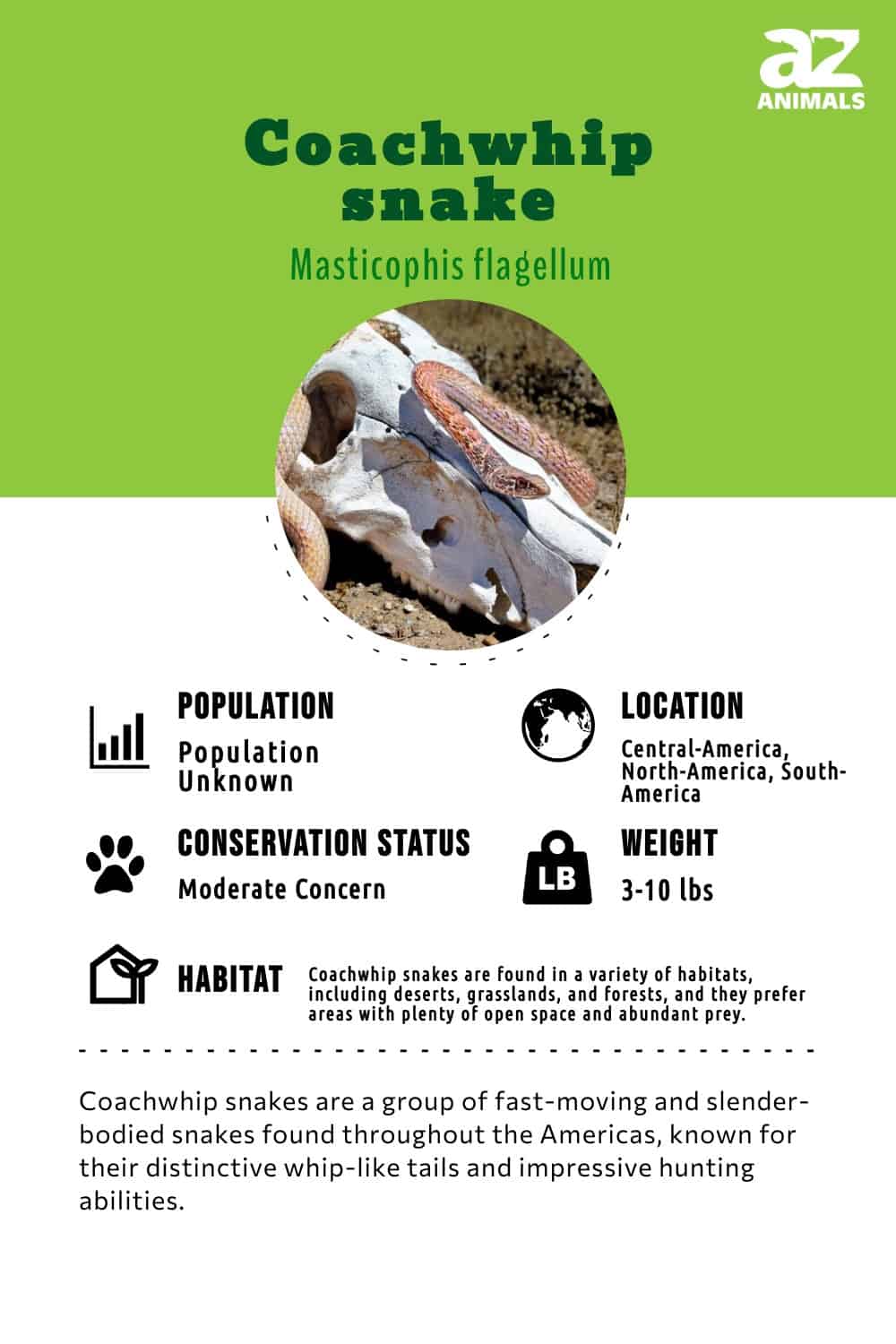
“The coachwhip snake gets its name from the resemblance to a lash used to drive a coach’s horse.“
The coachwhip is a member of the whip snake genus. These are very long, slender, non-venomous snakes native to the Americas. Because of how common they are, it is easy to accidentally come across one in the wild. Fortunately, they pose little danger to people.
5 Coachwhip Amazing Facts
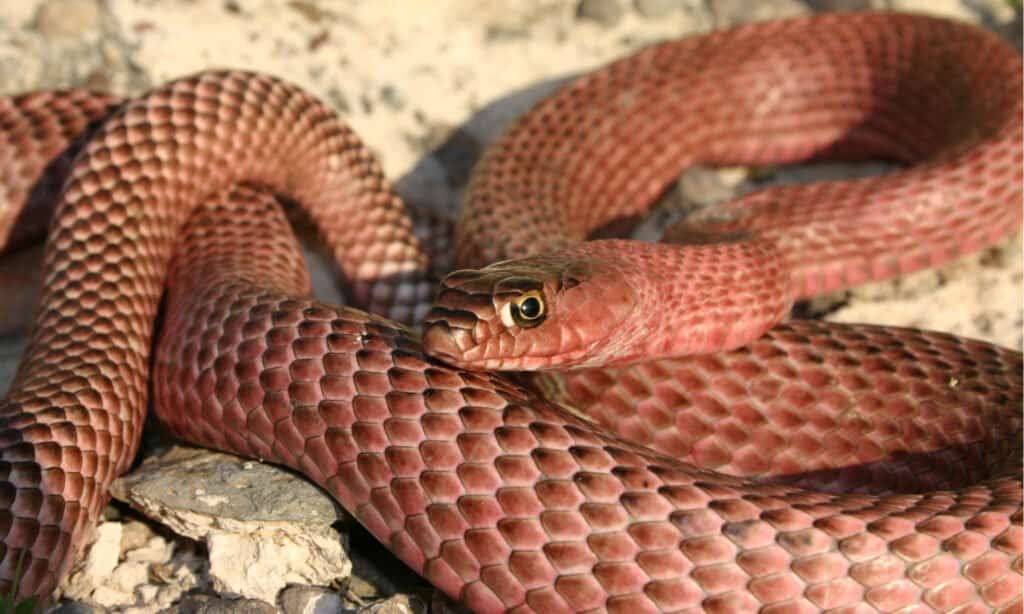
©Nathan A Shepard/Shutterstock.com
- The reproductive season of the coachwhip usually takes place in the late spring and summer months. Females may breed with several different males during this period. She will then lay up to 24 eggs in a small burrow (although the average number of eggs is just 11 eggs). It takes them more than two months for each baby to hatch on its own.
- The coachwhip is among the fastest snakes in the Americas. It has a maximum speed of about 4 miles per hour.
- The coachwhip tends to live about 13 years in the wild. The maximum age in captivity was recorded to be about 20 years.
- Coachwhip snakes maintain a small home range that they use for hunting. In the breeding season, male snakes will defend this location from rivals to protect any females within it.
- All sorts of myths have arisen around the coachwhip. One myth is that they have the ability to whip a person to death with their tail. Another myth is that they will suckle the milk from cows and other mammals, leaving the young baby calf without any milk. These myths are completely false.
Evolution and Origins
Coachwhip snakes are an intriguing collection of snakes that can be found from Canada to South America in much of the Americas. With long, slender bodies that may grow up to 8 feet long and a whip-like tail that gives them their common name, these snakes are recognized for their striking look. Coachwhips can hunt down animals including lizards, rodents, and birds because of their lightning-quick speed.
There is still substantial disagreement among experts regarding the evolution and origins of coachwhip snakes. One idea holds that they are closely related to the long, slender snakes that are known to hunt lizards in Africa, the species Psammophis.
However, according to other studies, coachwhips are more closely linked to North American rat snakes, which have comparable body structure and dietary preferences. Coachwhip snakes’ exact origins and evolutionary history must be explored further, but their unusual adaptations and astounding speed make them an interesting topic for future research.
Different Types
- Masticophis flagellum cingulum: Sonoran coachwhip
- Masticophis flagellum flagellum: Eastern coachwhip
- Masticophis flagellum lineatulus: Lined coachwhip
- Masticophis flagellum piceus: Red coachwhip, red racer
- Masticophis flagellum ruddocki: San Joaquin coachwhip
- Masticophis flagellum testaceus: Western coachwhip
Where to Find Coachwhips
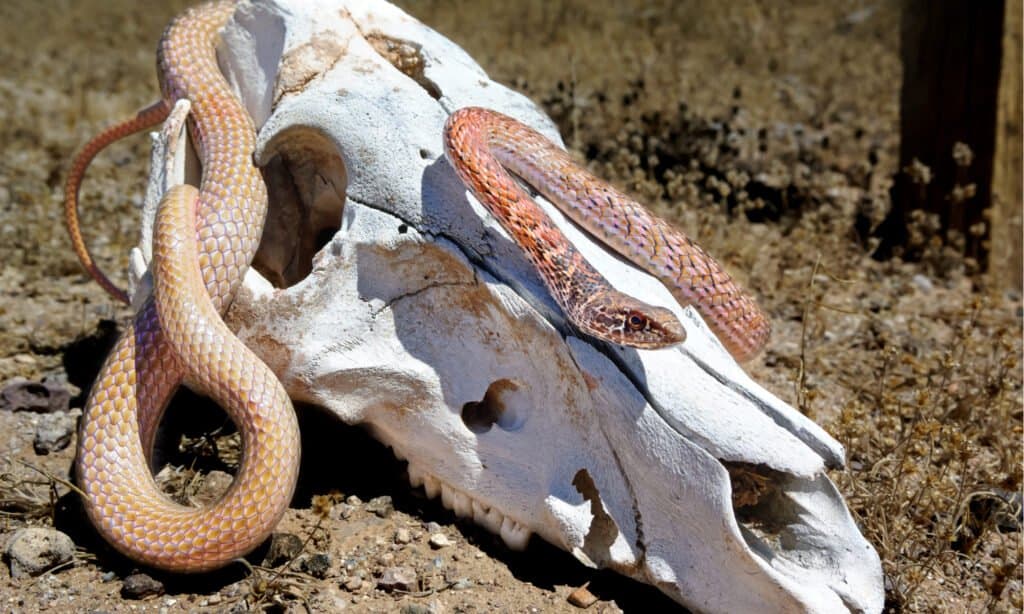
Coachwhip snakes live across much of the southern United States and Mexico.
©Deep Desert Photography/Shutterstock.com
The coachwhip is very common throughout the southern United States and northern Mexico, from the Pacific to the Atlantic coast, although apparently not around the Mississippi River. They prefer areas with loose, sandy soil, including prairies, coastal dunes, open pine forests, sandhills, and fields.
These snakes are most active during the hottest hours of the day. When it’s nighttime or cold out, they will typically seek refuge in underground burrows or beneath objects. During the winter, they do hibernate for extended periods to conserve energy.
There are six recognized subspecies, each with its own geographical range. The eastern coachwhip lives as far north as Missouri and as far south as Florida; it’s also bounded by the Atlantic in the east and Texas in the western part of its range. The western coachwhip lives as far south as Mexico City and all the way north to Nebraska; it’s also bounded by New Mexico in the western part and Texas in the eastern part of its range.
The Sonoran coachwhip can be found in a small region between Arizona and Sonora, Mexico. The San Joaquin coachwhip is found around northern California. The red coachwhip lives between southern California and Arizona. Finally, the Baja California coachwhip is found in that respective peninsula of Mexico.
Scientific Name
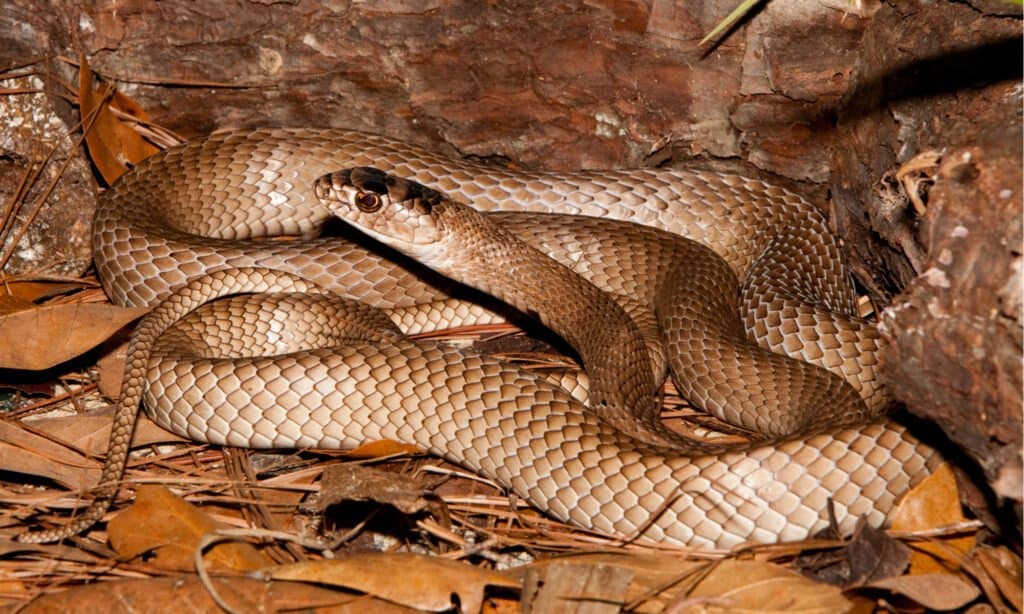
These snakes can be found in a wide variety of colors, including black, gray, tan, pink, reddish-brown, or any combination of these colors. They may also have broad crossbars of color.
©Jay Ondreicka/Shutterstock.com
The scientific name of the coachwhip is Masticophis flagellum. Masticophis is derived from two Greek words: mastix, meaning whip, and ophis, meaning snake. Flagellum comes from the Latin word flagrum, meaning whip or scourge. This is actually a common biological term used to describe many whip-like appendages on a variety of different organisms.
Population & Conservation Status
According to the IUCN Red List, the coachwhip is overall a species of least concern, but habitat loss and road accidents are responsible for a slight decline in numbers around some areas. The state of Illinois, for instance, lists it as an endangered species within its borders. But they are quite plentiful in the core of its territory, including Texas, Florida, and Arizona.
Appearance and Description

Coachwhips are long and slender snakes and can reach lengths up to eight feet.
©Alexander Wong/Shutterstock.com
The coachwhip is a long, slender snake that has the capacity to reach up to 8 feet in length. They are characterized by a small head, large eyes, and a scale pattern that resembles a braided whip. Coloration is probably the easiest way to identify them. The skin is black or dark brown around the head and slowly progresses to tan or white around the tail.
The exact range of colors varies across subspecies and locations. The red coachwhip subspecies feature dark red or pink hues. In Georgia and Florida, the coachwhip is almost completely tan. And the Sonoran coachwhip has black bands interrupted by smaller red bands. There are few differences between males and females, but the juvenile or baby coachwhips are generally tan or brown with white spots on the snout.
Here is how to identify the coachwhip:
- Extremely slender blender body, 3 to 8 feet in length
- Small head with large eyes
- The scale pattern resembles a braided whip
- Colors range from black or dark brown on the head to tan or white on the tail
Read about the largest coachwhip snake ever recorded.
How Dangerous Are They?
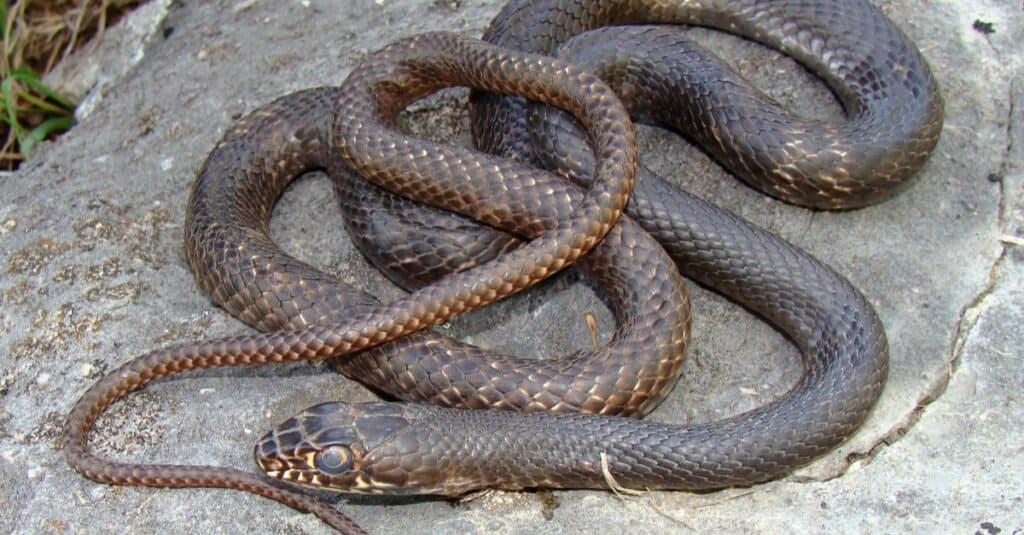
Coachwhip snakes are non-aggressive snakes found in South America.
©Matt Jeppson/Shutterstock.com
Coachwhips are not very dangerous at all. These are non-venomous snakes that generally defend themselves by standing up and biting. Although the bite can cause pain and swelling (the snake also has the tendency to tear away at the skin), it generally goes away after a short time.
There are no long-term complications unless the wound becomes infected, so it’s always a good idea to wash the wound out with soap and water to prevent this from occurring. If the wound looks more serious, then you may want to contact a doctor. Because of its speed, agility, and size, the coachwhip has few natural predators in the wild besides maybe coyotes and great horned owls.
Behavior and Humans
There are a number of old myths associated with the coachwhip that persist to this day. Some people believe it will chase after you and attempt to whip you with its tail out of self-defense, but this is completely false. If threatened, they will attempt to run away and hide. They will try to flee back to their underground burrow or even climb up trees.
If cornered, they may try standing up and biting at their harasser. And if handled or captured, some snakes may turn very aggressive, whereas others will go limp and attempt to play dead.
Similar Animals
View all 235 animals that start with CCoachwhip Snake FAQs (Frequently Asked Questions)
What's the difference between coachwhips and rattlesnakes?
The biggest difference between coachwhips vs rattlesnakes is that coachwhips are nonvenomous while rattlesnakes have venom. Coachwhip snakes do not have fangs and also have no rattle on their tail to warn potential aggressors.
Are coachwhips venomous?
No, this is not a venomous species. If you are bitten, then you only have to worry about the wound itself.
How do coachwhips hunt?
Unlike many other types of snakes, which sit and wait for their prey to approach, coachwhips are active hunters that go looking for food in the daytime and attack with their impressive speed. However, they use neither venom nor constriction to subdue prey. Instead, they strike out and grasp prey in their jaws, swallowing it alive or dead. Like all snakes, the coachwhip has the ability to capture odor particles directly from the air by licking with their tongue and then pressing the particles against an organ in the mouth. This helps them hunt for prey.
Are coachwhips aggressive?
Coachwhips are not aggressive toward people at all. They will take off in the opposite direction at the first sign of trouble. If confronted directly, they may try standing up on the front part of their body to ready themselves for a strike.
Where do coachwhips live?
Coachwhips can be found in prairies, coastal dunes, open pine forests, sand hills, and fields throughout the southern United States and northern Mexico.
What do coachwhips eat?
The diet of the coachwhip primarily consists of small lizards, rodents, frogs, insects, birds, and eggs.
Are coachwhip snakes rare?
They are not rare. Coachwhips are among the most common snakes throughout their entire natural range.
Will a coachwhip bite?
Biting is quite rare. It will only tend to occur if the snake is directly cornered, threatened, or surprised in some manner. You should always keep your distance to prevent this from occurring.
Is the eastern coachwhip snake poisonous?
The eastern coachwhip is a subspecies of the coachwhip. Just like the other members of its species, it does not contain any venom or poisons that would harm a human.
What do baby coachwhip snakes eat?
Juveniles will eat just about anything they can successfully hunt and attack. Insects are among their most common foods.
How does a coachwhip snake kill?
Lacking any means to poison or constrict its prey, the coachwhip will either try to bite it to death or just swallow the animal alive after an attack. This snake is only limited by the physical size of the prey.
How do coachwhips compare to cottonmouths?
Coachwhips are nonvenomous while cottonmouths contain venom. Beyond that important difference, coachwhips are also far more slender than cottonmouths and have a crosshatched pattern while cottonmouths are banded.
What are the differences between coachwhip snakes and black racers?
The key differences between coachwhip snakes and black racers are their appearance and their predators.
What are the differences between hognose snakes and coachwhip snakes?
The main differences between hognose snakes and coachwhip snakes are length, speed, appearance, and adaptation as pets.
What are the key differences between coachwhip snakes and chicken snakes?
The key differences between coachwhip snakes and chicken snakes are appearance, diet, habitat, speed, lifespan, and behavior.
What is the difference between a coachwhip and a copperhead?
A coachwhip differs from a copperhead in speed and length.
What are the key differences between a rat snake and a coachwhip snake?
Coachwhip snakes and rat snakes differ in size, speed, habitat, and appearance.
Thank you for reading! Have some feedback for us? Contact the AZ Animals editorial team.
Sources
- , Available here: https://srelherp.uga.edu/snakes/masfla.htm
- , Available here: https://animaldiversity.org/accounts/Masticophis_flagellum/

















